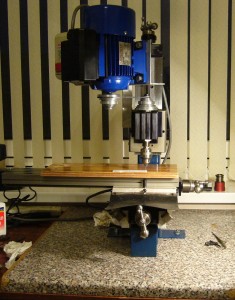Manual Mill
It took more than a day’s work to dismantle, clean, reassemble and adjust the Taig mill. Funny how sometimes you don’t realise just how filthy a thing is until you start scrubbing the layers of grime off it (in this case, dried oil and grease with swarf and dust embedded in it):
Shiny clean parts ready for reassembly:
I also replaced the leadscrew bearings in the Y axis because they had gone rather lumpy. I’ll probably do the other two axes as well soon.
Reassembled mill, bolted to an offcut of kitchen worktop and ready to start a precision drilling job.
I need to drill about 120 holes, precisely located by eye (under magnification), 1mm dia or less in 1.5mm thick sterling silver. Annoyingly I broke two expensive Swiss 0.7mm HSS bits within the first few holes (not entirely sure why – it doesn’t help that you have no feel at all for how much torque you are applying). I am now using a 0.9mm carbide PCB drilling bit (which is bigger than I would prefer), and have successfully made it through about 40 holes by peck drilling and feeding very slowly indeed. I’m probably spending about a minute on each hole. CNC would certainly make the job easier, even if I was only using it to manually jog to each hole location before running a few lines of code to automatically drill the hole at a consistent feed rate.










